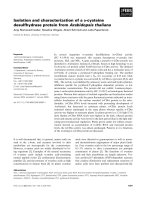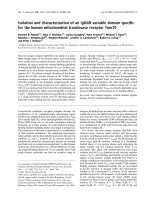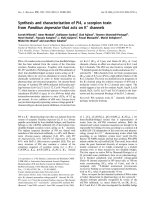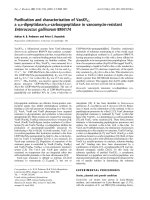Isolation and characterization of aurora a kinase interacting protein (AKIP), a novel negative regulator for aurora a kinase
Bạn đang xem bản rút gọn của tài liệu. Xem và tải ngay bản đầy đủ của tài liệu tại đây (7.4 MB, 330 trang )
ISOLATION AND CHARACTERIZATION OF
AURORA-A KINASE INTERACTING PROTEIN (AKIP),
A NOVEL NEGATIVE REGULATOR FOR
AURORA-A KINASE
LIM SHEN KIAT
(BSc [Hons], National University of Singapore, Singapore)
A THESIS SUBMITTED
FOR THE DEGREE OF DOCTOR OF PHILOSOPHY
DEPARTMENT OF PHARMACOLOGY
NATIONAL UNIVERSITY OF SINGAPORE
2006
Acknowledgements
_____________________________________________________________________
I would like to thank my direct supervisor, Dr. Ganesan Gopalan, Senior Scientist of Division of
Cellular and Molecular Research (CMR), National Cancer Centre (NCC) for his patient guidance
and constant encouragement throughout my PhD study. I am also grateful to him for critically
reading and correcting my thesis.
I would also like to thank my co-supervisors, Prof Hui Kam Man, Director of CMR Division,
NCC and Prof Uttam Surana, Principal Investigator of Institute of Molecular and Cellular
Biology (IMCB) for their close monitoring on the progress of my PhD project and offering of
constructive and helpful suggestions during the yearly committee meeting.
Million thanks to both Dr.Ganesan Gopalan and Prof Hui Kam Man for their grant support for my
PhD project throughout.
My sincere appreciation goes to all the current and ex- colleagues in my lab and Prof. Hui’s lab,
NCC for their friendship, encouragement and technical assistance throughout my PhD study.
I would like to specially thank my beloved wife, Shing Tsui Tsui for her dedicated love and
sacrifice as well as her endless moral support and encouragement. Last but not least, I thank my
family and friends for their continuous support and encouragement as well.
A million million thanks to all of you again for making everything possible for me.
Lim Shen Kiat
March 2006
i
Table of Contents
Acknowledgements
………………………………………………………………… …………i
Table of Contents…………………………………………………………………….… …….ii
List of Tables…………………………………… …………………………… ….……iii
List of Figures…………………………………………………… ………………………… iv
Abbreviations…………………………………… ……………………………………… ….xi
Summary……………………………………………………………………………………….xiii
SECTION 1 Introduction and Literature Review
Chapter 1 Aurora Kinase Family and Roles of Aurora-A Kinase in
Tumorigenesis, 1
Chapter 2 Negative Regulation of Aurora-A Kinase, 29
Chapter 3 Ubiquitin-Independent Protein Degradation Pathway, 49
Chapter 4 The Antizyme Family: Mediator of Ubiquitin-Independent
Proteasomal Degradation, 69
SECTION 2 Experimental Procedures
Chapter 5 Materials, 86
Chapter 6 Methods, 102
ii
SECTION 3 Results and Discussions
________________________________________________
Chapter 7 Identification of Aurora-A Kinase Interacting Protein (AKIP) and
Characterization of its Role in Negative Regulation of Aurora-A
Kinase, 125
Chapter 8 AKIP-mediated Aurora-A Kinase Protein Degradation Through
Alternative Ubiquitin-Independent, Proteasome-Dependent Pathway,
164
Chapter 9 Mechanism of Ubiquitin-Independent AKIP-mediated Aurora-A
Degradation: Role of Antizyme (AZ), 200
Chapter 10 Current View and Future Outlook, 231
SECTION 4 Appendices
Appendix I Published papers arising from thesis work, 242
List of Tables
Chapter 1
Table 1-1 Mitotic Kinases, 4
Table 1-2 Nomenclature of Aurora Family Kinases, 6
Table 1-3 Reported Aurora-A Kinase Abnormalities in Human Tumors, 12
Chapter 2
Table 2-1 Aurora Kinases Inhibitors, 39
Chapter 3
Table 3-1 Proposed Mechanisms for 20S Proteasome-Mediated Ub-Independent
Degradation, 57
Chapter 7
iii
Table 7-1 List of Candidate Suppressor Proteins Isolated from Yeast Dosage
Suppressor Screen, 130
List of Figures
Chapter 1
Figure 1-1 Overview of Eukaryotic Cell Cycle, 3
Figure 1-2 Cell Cycle and Kinase Signaling Cascades, 4
Figure 1-3 Structural Organization of Aurora Kinases, 7
Figure 1-4 Localization of Aurora Kinases During Cell Cycle, 9-11
Figure 1-5 Diagram Depicting the Predicted Tumorigenesis by Aurora-A
Overexpression, 15
Figure 1-6 Mad2 Binding to Kinetochores during Metaphase-Anaphase
Transition
in HeLa cells, 19
Chapter 2
Figure 2-1 A Model Linking Ran-GTP to Aurora-A Activation on Spindle Apparatus, 32
Chapter 3
Figure 3-1 Architecture of 20S and 26S Proteasome, 51
Chapter 4
Figure 4-1 Polyamine Biosynthesis, 70
Figure 4-2 Control of Polyamine Pool by Antizyme, 71
Figure 4-3 A Regulatory Feedback Mechanism Stabilizing Polyamine Pools, 72
Figure 4-4 Antizyme-Induced Translational Frameshifting, 73
Figure 4-5 Multiple Forms of Antizyme, 75
iv
Figure 4-6 Schematic Diagram Showing Antizyme (AZ) and Antizyme Inhibitor (AZI)
Mediated Regulation of ODC, 76
Figure 4-7 Antizyme-Induced ODC Degradation, 78
Chapter 6
Figure 6-1 Schematic Diagram of the GeneEditor In vitro Mutagenesis Procedure, 115
Chapter 7
Figure 7-1 Yeast Dosage Suppressor Screen, 128
Figure 7-2 Schematic Diagram Depicting the Yeast Dosage Suppressor Screen for
Isolation of Potential Aurora-A Negative Regulator(s), 129
Figure 7-3 AKIP Suppresses Aurora-A-Induced Yeast Cell Death,131
Figure 7-4 AKIP Amino Acid Sequence, 131
Figure 7-5 Amino Acid Sequence Alignment of Human, Mouse and Rat AKIP, 132
Figure 7-6 AKIP mRNA Expression in Various Human Tissues and Cancer Cell Lines,
133
Figure 7-7 AKIP mRNA Expression Pattern in Cell Cycle, 134
Figure 7-8 Functional Testing of AKIP Peptide Antibody, 135
Figure 7-9 Time-Dependent Stabilization of Endogenous AKIP Protein Upon
Proteasomal Inhibition, 136
Figure 7-10 Endogenous AKIP Protein in Various Cancer Cell Lines, 136
Figure 7-11 Nuclear Localization Signal (NLS) of AKIP, 137
Figure 7-12 Nuclear Localization of AKIP, 137
v
Figure 7-13 Doxycycline-Inducible AKIP-Expressing HeLa Tet-On Stable Cell Line, 138
Figure 7-14 Nucleolar-like Localization Pattern of AKIP, 138
Figure 7-15 Localization of AKIP in Interphase- Nucleolus, 139
Figure 7-16 Localization of AKIP in Mitosis- Mitotic Spindle in Metaphase, 139
Figure 7-17 Localization of AKIP in Mitosis-Post-Mitotic Bridge in Telophase, 140
Figure 7-18 Colocalization of AKIP and Aurora-A in Mitosis, 140
Figure 7-19 Overview of Yeast Two-Hybrid Assay, 141
Figure 7-20 In vivo Interaction of Exogenous Aurora-A vs Exogenous AKIP: Aurora-A
Immunoprecipitation, 143
Figure 7-21 In vivo Interaction of Exogenous Aurora-A vs Exogenous AKIP:
AKIP Immunoprecipitation, 144
Figure 7-22 In vivo Interaction of Endogenous Aurora-A vs Exogenous AKIP:
AKIP Immunoprecipitation, 145
Figure 7-23 In vivo Interaction of Endogenous Aurora-A vs Exogenous AKIP: Aurora-A
Immunoprecipitation, 145
Figure 7-24 Effect of AKIP Overexpression on Exogenous Aurora-A, 147
Figure 7-25 Dose-Dependence of AKIP-Mediated Down-regulation of Aurora-A Protein,
148
Figure 7-26 Time-Dependence of AKIP-Mediated Down-regulation of Aurora-A
Protein, 148
Figure 7-27 AKIP and its Various Deletion Mutants, 149
vi
Figure 7-28 In vivo Interaction between Aurora-A and AKIP Deletion Mutants: Aurora-A
Immunoprecipitation, 151
Figure 7-29 AKIP Mutants-mediated Aurora-A Degradation, 152
Figure 7-30 Effect of AKIP Overexpression on Mouse Aurora-B stability, 153
Figure 7-31 Effect of AKIP Overexpression on Human Aurora-B stability, 153
Figure 7-32 Effect of AKIP Overexpression on Human Cyclin B1 stability, 154
Figure 7-33 Proteasome-Dependence of AKIP-mediated Aurora-A Degradation, 155
Chapter 8
Figure 8-1 Cell Cycle-Independence of AKIP-TR-mediated Aurora-A Degradation, 169
Figure 8-2 Stability of Wild-type and A Box Stabilizing Mutant of Aurora-A from M to
G1 Transition, 170
Figure 8-3 Effect of AKIP Overexpression on Stability of A-Box Mutant of Aurora-A,
171
Figure 8-4 Aurora-A Polyubiquitination in the Presence of AKIP, 173
Figure 8-5 Aurora-A Kinase and its Various Deletion Mutants, 175
Figure 8-6 Mapping for Ubiquitination Domain in Aurora-A, 177
Figure 8-7 Mapping of AKIP-TR-Interacting Domain in Aurora-A, 178
Figure 8-8 p21, A Target for Ubiquitin-Independent Degradation Pathway, 180
Figure 8-9 Cyclin B1, A Target for Ubiquitin-Dependent Degradation Pathway, 180
Figure 8-10 Aurora-A, A Target for Ubiquitin-Independent Degradation Pathway, 181
vii
Figure 8-11 Ubiquitin-Independent Degradation of Endogenous Aurora-A Kinase, 182
Figure 8-12 Suppression of Cellular Polyubiquitination of Aurora-A via Overexpression
of K48R Ubiquitin Mutant, 184
Figure 8-13 Effect of Polyubiquitination Suppression on AKIP-TR-mediated
Aurora-A
Degradation: Overexpression of K48R Ubiquitin Mutant, 185
Figure 8-14 Effect of Polyubiquitination Suppression on AKIP-TR-mediated Aurora-A
Degradation:Inactivation of E1 Ub-Activating Enzyme, 186
Figure 8-15 Effect of AKIP-TR Overexpression on Aurora-B Protein Stability, 187
Figure 8-16 Effect of AKIP-TR Overexpression on p21 Protein Stability, 188
Figure 8-17 Effect of AKIP-TR Overexpression on Cyclin B1 Protein Stability, 188
Figure 8-18 Proteasome-Dependence of Ub-Independent Degradation of Aurora-A via
AKIP-TR: A-Box Mutant, 189
Figure 8-19 Proteasome-Dependence of Ub-Independent Degradation of Aurora-A via
AKIP-TR: K48R Ubiquitin Mutant, 190
Chapter 9
Figure 9-1 Effect of Antizyme Overexpression on Exogenous Aurora-A Stability, 204
Figure 9-2 Effect of Antizyme Overexpression on Endogenous Aurora-A Stability, 204
Figure 9-3 Effect of Endogenous Antizyme Induction on Endogenous Aurora-A
Stability, 205
Figure 9-4 Effect of Antizyme Overexpression on Aurora-A A Box Mutant Protein
Stability, an Ubiquitination-Defective Mutant, 206
viii
Figure 9-5 Effect of Polyubiquitination Suppression on AZ-mediated Aurora-A
Degradation: Inactivation of E1 Ubiquitin-Activating Enzyme, 207
Figure 9-6 Proteasome-Dependence of Antizyme-mediated Aurora-A Degradation, 207
Figure 9-7 In vivo Interaction between Aurora-A and Antizyme, 208
Figure 9-8 Mapping of AZ1-Interacting Domain in Aurora-A, 210
Figure 9-9 Effect of Impaired Aurora-A:AZ1 Interaction on AZ1-mediated Aurora-A
Degradation, 211
Figure 9-10 Effect of Antizyme Inhibition via Antizyme Inhibitor (AZI) on AKIP-TR-
mediated Aurora-A Degradation, 213
Figure 9-11 Effect of Impaired Aurora-A: Antizyme Interaction on AKIP-TR-mediated
Aurora-A Degradation, 214
Figure 9-12 In vivo Interaction between AKIP-TR and Antizyme, 215
Figure 9-13 In vivo Ternary Complex of Aurora-A : AZ1 : AKIP-TR, 216
Figure 9-14 Binding Affinity of Antizyme to Aurora-A in the Presence of AKIP-TR, 218
Figure 9-15 Binding Affinity of AKIP to Aurora-A in the Presence of Antizyme, 219
Figure 9-16 Effect of AKIP-TR Overexpression on Translational Frameshifting and
Expression of Antizyme, 220
Chapter 10
Figure 10-1 Hypothesis of Possible Anti-Tumour Role of AKIP-mediated Ub-
Independent Degradation of Aurora-A, 234
ix
Abbrevations
aa
amino acid
A Box
Aurora box
AD
Activation domain
ADH
Alcohol dehydrogenase
AIK1
Human Aurora-A Kinase
AKIP
Aurora-A Interacting Protein
ALLM
N-acetyl-Leu-Leu-methional
ALLN
N-acetyl-Leu-Leu-norleucinal
AML
acute myelogenous leukemia
Amp
Ampicillin
APC/C
anaphase-promoting complex/cyclosome
ATP
Adenosine triphosphate
AURKA
Aurora-A Kinase
AZ
antizyme
AZI
Antizyme Inhibitor
bp
base pair
BSA
bovine serum albumin
CDK
cyclin dependent kinase
cDNA
Complementary DNA
Chfr
Checkpoint protein with FHA and Ring domain
CHO
Chinese Hamster Ovary
CHX
Cycloheximide
CIN
Chromosome Instability
conc
concentration
CO-IP
Co-immunoprecipitation
DAD
D box activating domain
DB domain
DNA binding domain
D box
Destruction box
DMSO
Dimethyl Sulfoxide
Dox
Doxycycline
dNTP
deoxynucleotide triphosphate
EST
expressed sequence tag
Ex
exposure
FBS
fetal bovine serum
GADPH
Glyceraldehyde-3-phosphate dehydrogenase
Gal
Galactose
GAP
GTPase activating protein
Glu
Glucose
x
HCC
Hepatocellular carcinoma
His
Histidine
Hr
hour
HURP
Hepatoma Upregulated Protein
IAK1
mouse Aurora-A kinase
Ile
Isoleucine
Imp
Importin
IP
Immunoprecipitation
kDa
kilo Dalton
Leu
Leucine
LiAc
Lithium Acetate
M phase
Mitosis phase
mAb
monoclonal antibody
MEN
Mitotic Exit Network
MG132
Carbobenzoxy-L-leucyl-L-leucinal
min
minute
mRNA
messenger RNA
MTOC
microtubule organizing centre
N terminus
amino terminus
NEK
NimA-related kinase
NLS
Nuclear localization signal
nt
nucleotide
ODC
ornithine decarboxylase
ORF
open reading frame
Orn
ornithine
pAb
Polyclonal antibody
PBS
Phosphate Buffered Saline
PCR
polymerase chain reaction
Phe
Phenylalanine
PI
Propidium Iodide
PKA
protein kinase A
PLK
polo-like kinase
pmol
Pico mole
PP1
protein phosphatase 1
Pu/Put
putrescine
RACE
Rapid amplification of cDNA ends
RB
Retinoblastoma
xi
RT
room temperature
SD
synthetic dropout
SDS
Sodium dodecyl sulphate
sec
second
Ser
Serine
SH3
Src Homology 3
siRNA
small interfering RNA
Spd
spermidine
Spm
spermine
SSD
sensor and substrate discrimination
SUMO
small ubiquitin-like modifier
TBS
Tris-buffered saline
TCR
T cell recptor
Thr
Threonine
TR
N-terminal truncated
Trp
Tryptophan
Ub/Ubiq
Ubiquitin
wt
wild type
xii
Summary
Aurora kinases have evolved as a new family of centrosome- and microtubule-associated
serine/threonine kinases that regulate multiple processes in mitosis, such as centrosome
duplication and maturation, chromosome condensation, bipolar spindle assembly and dynamics,
cytokinesis and checkpoint control. One of its members, Aurora-A kinase is a potential oncogene.
Overexpression of Aurora-A kinase causes centrosome amplification and defective chromosome
segregation, leading to aneuploidy and tumorigenesis in various cancer cell types.
Our objective is to identify the negative regulator(s) for mammalian Aurora-A kinase.
Exploiting the lethal phenotype associated with overexpression of Aurora-A kinase in yeast, we
performed a dosage suppressor screen in yeast and successfully isolated a novel negative
regulator of Aurora-A kinase, named as AKIP (
Aurora-A Kinase Interacting Protein). AKIP is an
ubiquitously expressed nuclear protein that interacts specifically with human Aurora-A in vivo.
AKIP targets Aurora-A for protein destabilization in a proteasome-dependent manner. AKIP-
Aurora-A interaction is essential for the AKIP-mediated Aurora-A degradation.
Aurora-A kinase normally undergoes cell cycle-dependent turnover through the Cdh1-
mediated APC/C-ubiquitin-proteasome pathway. In an attempt to investigate the mechanism of
AKIP-mediated Aurora-A degradation, AKIP was found to potentiate the proteasome-dependent
xiii
degradation of Aurora-A by an alternative mechanism that is independent of ubiquitination. This
implies Aurora-A kinase can be delivered to the proteasome for degradation via two distinct
ubiquitin-dependent and ubiquitin-independent pathways. AKIP inhibits Aurora-A ubiquitination,
through its interaction with the potential ubiquitination region of Aurora-A.
Interestingly, AKIP-mediated Aurora-A degradation is functionally linked to a family of protein,
called antizyme (AZ), which plays the proteasomal targeting role and mediates the Ub-
independent degradation of some proteins. Antizyme can directly down-regulate Aurora-A
protein stability, which is dependent on antizyme:Aurora-A interaction. Interestingly, defective
antizyme:Aurora-A interaction or inhibition of antizyme function impairs AKIP-mediated
Aurora-A degradation, implying AKIP and antizyme function on the same or parallel pathways in
the ubiquitin-independent degradation of Aurora-A. AKIP indeed acts upstream of antizyme by
enhancing binding of antizyme to Aurora-A, thereby targeting Aurora-A for proteasomal
degradation.
xiv
SECTION 1
Introduction and Literature Review
_____________________________________________________________________
(Introduction and Literature Review)
Chapter 1
Aurora Kinase Family and Roles of Aurora-A Kinase in
Tumorigenesis
1.1 Mitosis, 2
1.1.1. Overview of Eukaryotic Cell Cycle-Mitosis, 2
1.1.2. Regulation by Mitotic Kinases, 3
1.2 Aurora Kinases, 5
1.2.1. Members of Aurora Kinase Family, 5
1.2.2. Domain Organization of Aurora Kinases, 6
1.2.3. Aurora Kinases Expression, Subcellular Localization and Functions in
Mitosis, 7
1.3 Role of Aurora-A Kinase in Tumorigenesis, 12
1.3.1. Association with Multiple Cancers, 12
1.3.2. Phenotypes Associated with Overexpression of Aurora-A Kinase,
13
1.3.3. Mechanisms of Aurora-A-induced Tumorigenesis, 14
1.3.3.1. Abrogation of post-mitotic G1 checkpoint, 14
1.3.3.2. p53 Inactivation, 16
1.3.3.3. Overriding Spindle Assembly Checkpoint, 17
1.3.3.4. Aurora-A as Tumour Susceptibility Gene, 20
1.3.3.5. Enhanced Cell Migration, 20
1.3.3.6. Transforming Target—HURP, 21
1.4. References, 22-28
1
1.1 Mitosis
1.1.1 Overview of Eukaryotic Cell Cycle-Mitosis
Mitosis, though it is the shortest phase of the cell cycle, is highly structurally dynamic and
plays a critical role in segregating the newly synthesized chromosomes symmetrically and
accurately into the two daughter cells. By end of S phase, the centrosome duplication and
DNA replication are accomplished. When the cells first enter into prophase, the chromatin
condenses and the nuclear envelope breaks down. At the end of prophase, the mature
centrosome pair separates and migrates to the opposite poles of the nucleus to serve as two
microtubule-organizing centres (MTOCs). Prometaphase follows where the microtubules
nucleate from the MTOCs, forming the bipolar spindle. Subsequent to progression into
metaphase, the kinetochores capture the plus ends of microtubules and this facilitates the
chromosomal bi-orientation and alignment at the metaphase plate in the center of mitotic
spindle. In the meantime, there is a continuous activation of mitotic checkpoint to monitor the
microtubule attachment to kinetochores and tension. Upon progressing into anaphase, the
chromatids start to segregate to the opposite spindle poles and this process is facilitated by the
gliding of polar-oriented microtubules. ATPase driven motors such as dynein, kinesins and
kinesin-related proteins and their dynamic temporal and spatial coordination play an essential
role during the process. During the telophase, nuclear division occurs. Actin and myosin also
redistribute to form an actin ring, called post-mitotic bridge in the midzone region between
the poles. Contraction of the actin ring initiates the destruction of the post-mitotic bridge and
2
cytokinesis [1-2]. An overview of eukaryotic cell cycle, in particularly M phase is shown in
Figure 1-1.
Figure 1-1: Overview of Eukaryotic Cell Cycle
(Figure adapted from ref [3])
1.1.2. Regulation by Mitotic Kinases
All these mitotic events are tightly governed by three regulatory mechanisms: protein
localization, proteolysis and phosphorylation. Several protein kinases and their opposing
phosphatases had been identified [2]. The best-studied kinases for the cell cycle progression
are the cyclin-dependent kinases (CDKs) [4], which complex with cyclins and regulate
various processes in mitosis, from DNA replication till mitotic entry and exit. Besides, the
polo-like kinases (PLKs) [5] regulate the centrosome maturation, CDK1 activation and
inactivation, and cytokinesis. In addition, the NimA-related kinases (NEKs) [6] regulate the
centrosome cycle. Moreover, the kinetochore-localized Bub1 [7] kinase regulates the
anaphase checkpoint signaling. Table 1-1 summarizes all the above kinases implicated in
3
mitotic progression and checkpoints. Figure 1-2 displays where the major checkpoints exert
quality control over mitotic progression and where mitotic kinases are thought to act.
Table 1-1: Mitotic Kinases (Table adapted from ref [1])
Figure 1-2: Cell Cycle and Kinase Signaling Cascades (Figure adapted from ref[1])
4
1.2. Aurora Kinases
1.2.1. Members of Aurora Kinase Family
Recently, a new family of conserved mitotic serine/threonine kinase, named as Aurora
kinase [1, 8-9] had been identified and played the implicated roles in centrosome separation
and maturation, spindle assembly and stability, chromosome condensation, congression and
segregation and cytokinesis. Homologues of Aurora kinase had been isolated in various
organisms, including yeast, Caenorhabditis elegans, Drosophila and vertebrates. Mammalian
genome encodes for three members, namely Aurora-A (also known as Aurora-2, AIR-1, AIK1,
AIRK1, AYK1, BTAK, Eg2, IAK1, STK15), Aurora-B (also known as Aurora-1, AIM-1,
AIK2, AIR-2, AIRK-2, ARK2, IAL-1 and STK12) and Aurora-C (also known as AIK3), while
for other metazoans, like Xenopus laevis, Drosophila melanogaster and Caenorhabditis
elegans, only Aurora-A and Aurora–B kinases were found, whereas the yeast genomes of
Saccharomyces cerevisiae and Schizosaccharomyces pombe encoded only one Aurora-like
homolog. Ipl1p from budding yeast S. cerevisiae and Aurora from Drosophila melanogaster
are the founding members of Aurora kinase family. Ipl1p was identified through a genetic
screen for mutations that led to increased chromosome missegregation [10]. Table 1-2
summarizes the nomenclature of the Aurora family kinases.
5
Table 1-2: Nomenclature of Aurora Family Kinases (Table adapted from ref[1])
1.2.2. Domain Organization of Aurora Kinases
The three Aurora kinases (309-403 a.a) share the similar domain organization, with their
catalytic kinase domain flanked by very short C-terminal tail (15-20 a.a.) and N-terminal
domain of variable length (39-129 a.a.). The N-terminal domain is highly variable in sequence
and length between Aurora members and this confers selectivity and specificity for
protein-protein interaction, whereas the catalytic kinase domain is highly conserved (67-76%
identity), even across different organisms. The most conserved motif is the activation loop,
which contains a highly conserved threonine residue (Thr288). Though all three Aurora
kinases are similar in structure, they display different expression patterns, subcellular
localizations and timing of activation [8, 11-12]. Figure 1-3 shows the domain organization of
the Aurora kinases.
6
Figure 1-3: Structural Organization of Aurora Kinases (Figure adapted from ref [11])
KEN Box
1.2.3. Aurora Kinases Expression, Subcellular Localization and Functions in Mitosis
Aurora-A kinase is ubiquitously expressed, low in most tissues, yet high in tissues with high
mitotic and meiotic index, such as thymus, fetal liver and testis. Aurora-A mRNA and protein
expression levels as well as its kinase activity are cell cycle regulated, low in G1/S phase,
peaking in G2/M and then dropping upon mitotic exit into the next G1. Aurora-A kinase
displays dynamic subcellular localization, localized initially to the duplicated centrosomes at
the end of S phase, translocating to mitotic spindle from prophase through telophase.
Activation of centrosomal Aurora-A at late G2 phase is essential for centrosome maturation
and mitotic entry. Its further activation and translocation are required for centrosome
separation, leading to subsequent bipolar spindle formation and chromosomal alignment.
7
Upon completing cytokinesis, Aurora-A kinase has to be rapidly degraded and inactivated.
In summary, Aurora-A kinase
plays a critical mitotic role in centrosome separation and
maturation, microtubule nucleation and bipolar spindle assembly [8-9, 11-16].
Aurora-B kinase is also highly expressed in tissues with a high mitotic index. Its mRNA
and protein expression levels are also cell cycle regulated, peaking at G2/M phase and its
kinase activity reaches the maximal from metaphase till end of mitosis. Aurora-B is identified
as one of the components for the “chromosomal passenger protein” complex
(Aurora-B-INCENP-survivin-borealin), which plays an important role in coordinating the
chromosomal functions and cytoskeletal functions. Therefore Aurora-B kinase displays highly
dynamic localization change in mitosis. Aurora-B associates along the chromosome arms
during prophase, and is later concentrated at inner centromeres (kinetochore) in metaphase. At
the anaphase onset, it translocates to the spindle midzone and cell cortex, the site for cleavage
furrow formation. Aurora-B, thus, has multiple roles in mitosis, which include chromosome
condensation, cohesion, bi-orientation, cytokinesis and spindle assembly checkpoint [8-9,
11-16].
Aurora-C, though found prominently in testis, is also detected in other cell types and is
overexpressed in certain cancer cell lines. Just like Aurora-A and –B, its mRNA and protein
expression levels are cell cycle-dependent, peaking at G2/M. Like Aurora-B, Aurora-C is also
a chromosomal passenger protein, localizing initially to the centromeres and then to the
8
spindle midzone. Hence, the function of Aurora-C kinase overlaps with and complements the
function of Aurora-B kinase in mitosis [8-9, 11-16].
Figure 1-4 (A-D) gives an overview of the subcellular distribution of the Aurora kinases
and their functional roles throughout mitotic cell cycle.
Figure 1-4: Localization of Aurora Kinases During Cell Cycle
(Figure above adapted from ref [3])
A
9









